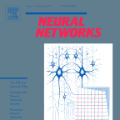Geomagnetic disturbance forecasting is based on the identification of solar wind structures and accurate determination of their magnetic field orientation. For nowcasting activities, this is currently a tedious and manual process. Focusing on the main driver of geomagnetic disturbances, the twisted internal magnetic field of interplanetary coronal mass ejections (ICMEs), we explore a convolutional neural network's (CNN) ability to predict the embedded magnetic flux rope's orientation once it has been identified from in situ solar wind observations. Our work uses CNNs trained with magnetic field vectors from analytical flux rope data. The simulated flux ropes span many possible spacecraft trajectories and flux rope orientations. We train CNNs first with full duration flux ropes and then again with partial duration flux ropes. The former provides us with a baseline of how well CNNs can predict flux rope orientation while the latter provides insights into real-time forecasting by exploring how accuracy is affected by percentage of flux rope observed. The process of casting the physics problem as a machine learning problem is discussed as well as the impacts of different factors on prediction accuracy such as flux rope fluctuations and different neural network topologies. Finally, results from evaluating the trained network against observed ICMEs from Wind during 1995-2015 are presented.
翻译:地磁扰动预测基于太阳风结构的识别和磁场方向的准确确定。 对于当前播送活动来说,这是一个枯燥和人工的过程。侧重于地磁扰动的主要驱动因素,即行星间日冕物质抛射的扭曲的内部磁场,我们探索一个演动神经网络的能力,一旦从现场太阳风观测中发现嵌入磁通绳的方向,即进行预测。我们的工作使用受过分析通量绳数据磁场矢量分析训练的CNN。模拟通量绳覆盖许多可能的航天器轨迹和通量绳方向。我们先用全时通量绳对CNN进行训练,然后又再用部分时间通量绳进行训练。前者为我们提供了一个CNN能够预测通量绳方向的基线,而后者则通过探索所观察到的通量绳百分比如何影响实时预报。我们讨论了作为机器学习问题而揭示物理问题的过程,以及1995年所观测到的流绳子波动和不同2015年电流网络顶部结果等不同因素对预测准确性的影响。最后,对1995年所观测的CNN能够预测通量绳向方向提供了一个基线。














